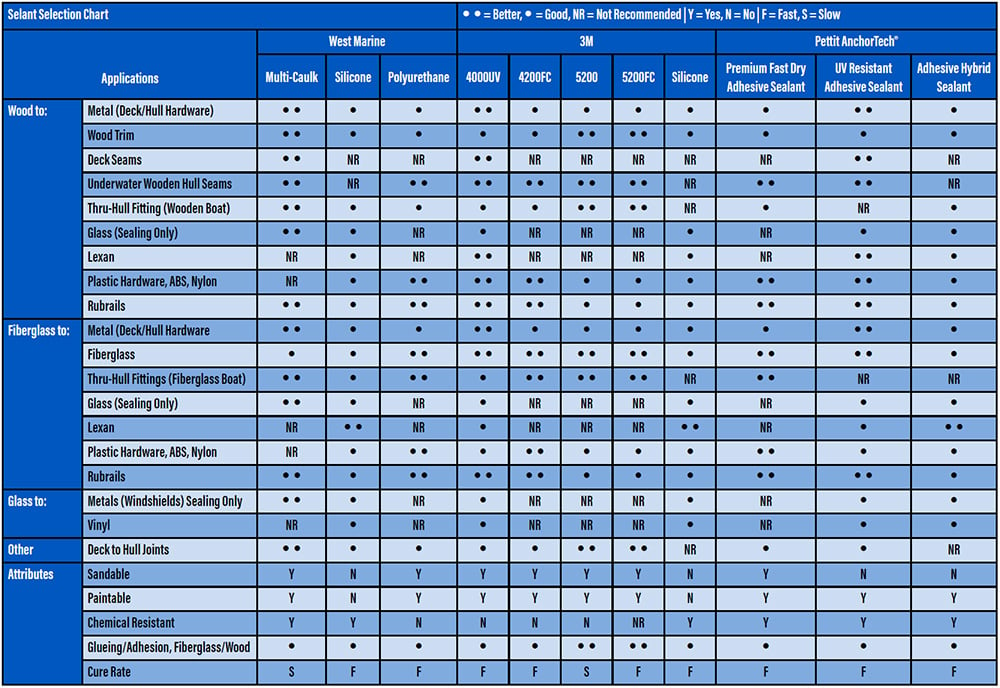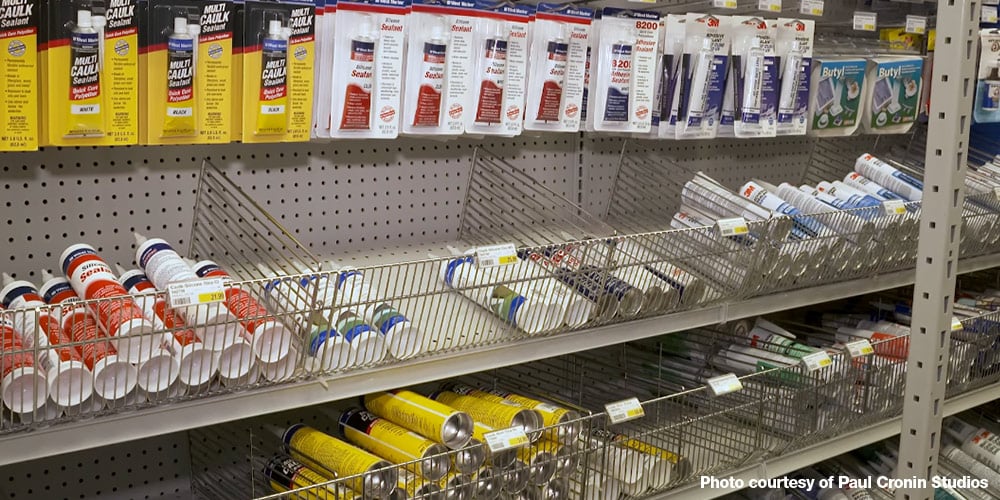
What Sealants Do
Marine applications for caulking are far more demanding than the typical household or automotive repair. The exposure to the extreme outdoor conditions of water, salt and sun put a tremendous stress on the bonds to fiberglass, wood, and a variety of marine substrates. They need to form a watertight and airtight seal between two or more surfaces. Some will need to provide an adhesive bond as well (often supported by mechanical fasteners); others are used for sealing purposes only or to isolate one surface from another against electrolysis, vibration or noise. We'll walk you through your marine caulking and adhesive options and help you choose the right one for your project.
- How Sealants Work
- What Materials are You Bonding or Sealing
- Choosing the Right Sealant
- Sealants and Caulking Compound Formulations
- Marine Sealant Curing Times
- Sealant Smarts
How Sealants Work
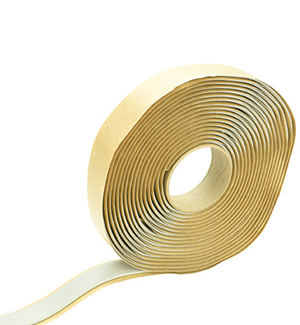
Butyl Caulking Tape is a popular alternative to liquid sealants.
Marine caulking sealants cure to a durable, flexible, rubbery consistency, adhering to surfaces to prevent water or air from penetrating. Because sealants are permanently flexible, they can withstand some movement of the surfaces to which they are bonded without losing adhesion. This is referred to as elongation. The bonding strength varies from moderate to extremely strong. In the case of some adhesive-sealants it can be considered nearly permanent.
Drying times and curing times can vary. There is typically a tack or skin time - your working time, dry time – may return to service and full cure time – completely cured. Full Curing time can range from a day to a week or more. Weather plays a big role in this curing process, and may accelerate or slow the curing process. It is always recommended to read the product's technical data sheet for these times. The data sheet will also detail the proper surface preparation steps and it is critical to only clean and prepare to the manufacturers specification as some cleaners, such as alcohol, can stop the material from curing properly.
What Materials are you Bonding or Sealing?
The application and the kind of materials you plan to bond will determine the choice of marine caulking you need. Applications below the waterline will require a product that is designed to be submerged. Applications above the waterline may need adhesive strength for items such as deck hardware, or simply need sealing properties for light duty applications such as electronics installations. If you are working with dissimilar surface materials, make sure the sealant works with both of them using the chart below.
Click the chart to view the full size PDF
Choosing the Right Sealant
Temporary or permanent bonding: Consider the application carefully. If it will ever be a serviceable item you are bonding/sealing, you may consider an adhesive-sealant product with great strength, but not so much that it damages your vessel when it comes time to remove. Some products, like 3M 5200, have a reputation for secure bonding that should not be taken lightly. We’ve seen a 10,000 lb. keel which was put on with 5200 that held so strongly that it practically delaminated the hull during an attempted separation. Use compounds with less tenacious adhesive qualities if you know that you’ll have to remove the item at a future date, for example when bedding deck fittings. 3M’s Fast Cure 4200 has half the strength of 5200, which (with some effort) allows for disassembly of parts.
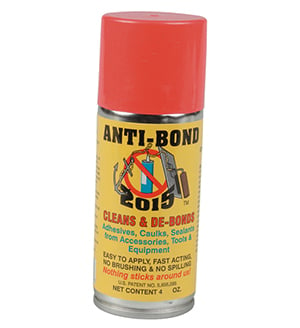
Marine adhesive removers like Anti Bond 2015 debond and aid in the removal of most polyurethane sealants.
A bond created with 3M 5200 may last forever, so you are in a pickle if you later decide to separate the two surfaces. The solution is a marine adhesive remover like Anti-Bond 2015, which breaks the bond between the adhesive and the substrate, so deck hardware can be removed. Penetration can be encouraged by first scoring the edge of the bond with a blade, which might be required in the case of winches or other hardware that have been in place for years. Anti-Bond 2015 can be a real life saver in the case of hardware that is difficult to remove.
Aesthetics and Paintability:Consider whether the application will be visible and will need to look fresh and clean or whether it will be painted in the process. Different formulations may not weather as well or may require painting while wet. A UV stable and easily paintable product would be beneficial in this application.
Chemistry: Consider the work time of the product along with the ease of use. Polyurethane and polysulfide products have been the traditional formulas for many years as they can have longer work time for larger areas and are very strong. New modified polymer formulas are great options as well but, as always, it is critical to check the product's technical data sheet to ensure compatibility with the surface you're working on.
Sealants and Caulking Compound Formulations
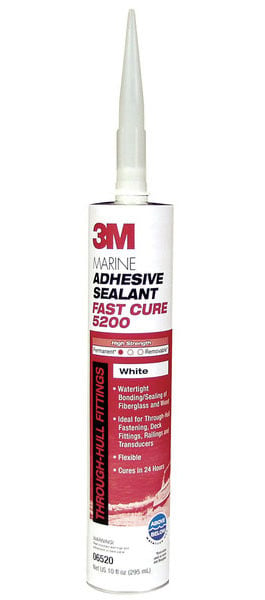
3M 5200 Fast Cure is messy to work with but is very tenacious as a marine adhesive and sealant.
Polyurethane: Recommended for permanent bonding because of its enormous adhesive strength of about 700psi, polyurethane is more of an adhesive than a sealant. It is good for hull/deck joints and bonding thru-hull fittings but incompatible with ABS and Lexan, and does not adhere well to many other types of plastic. Polyurethanes have poor resistance to oil and the acids used in products such as teak cleaners. Do not use polyurethane-based sealants if the bonded items might have to be separated in the future.
Silicone: Versatile, quick and easy to use, elastic and highly resistant to chemicals, silicone is excellent for isolating dissimilar metals. It is not as strong in adhesive strength as polysulfide or polyurethane. Depending on compression from mechanical fasteners to maintain its grip, it’s more of a gasket material than a sealant, but is compatible with plastics. A big disadvantage is that silicone caulks leave a silicone-based residue behind that’s difficult to remove, to which nothing will adhere, including fresh silicone or paint (silicone is not paintable either, but polyurethane, polyether and polysulfide are).
Polysulfides: Perhaps the most versatile sealants available are synthetic rubber sealants called polysulfides. Two-part polysulfides, such as Life- Calk Deck Seam Sealant, have long been popular as caulking material for teak decks or for bedding wood parts like rubrails and cockpit coamings. One-part polysulfides, like Life-Calk, are easier to use, just as durable, but slower to cure. Both bond well to most surfaces but oily woods (such as teak) should be primed with Life-Calk Primer.
We don’t recommend polysulfides for bonding plastic, as they will melt some types. You shouldn’t use polysulfide to bed plastic windshields or plastic portlights, either acrylic (Plexiglas) or polycarbonate (Lexan). Don’t use it to bed plastic deck fittings or portlight frames, either. They’re usually made from ABS or PVC, and polysulfide will attack both. You can safely bed plastic fittings made from epoxy, nylon or Delrin with polysulfide.
Polyether: One of the most exposure resistant sealants, unaffected by teak oils or cleaners, permanently flexible, and sandable. West Marine Multi-Caulk is an excellent choice for wood, metal, or fiberglass but will attack some plastics. However, 3M 4000UV is rated as being safe for all plastics.
Flexible epoxy formulations: Epoxy variations, like Pettit FlexPoxy and WEST System G-Flex, are more flexible and less brittle than traditional epoxies. They cure faster than some polyurethanes, adhere well to many materials and may be another alternative to consider when you want a permanent and somewhat flexible bond.
Marine Sealant Curing Times
Marine sealants all require various periods of time to cure properly. Frequently, the most tenacious and best-performing products take the longest time to cure. Here are a couple of examples: Life-Calk, preferred for deck seams, takes 10-20 days for a complete cure. The strongest slow-cure version of 3M 5200 takes 5-7 days.
These slow-cure products provide lots of working time, but also can potentially prolong a haulout or confine you to the dock over the weekend. Make sure you plan ahead. Even if you are able to use the boat, you could easily damage the bond depending what part of the boat is affected. On the other hand, moisture in the air or dew on the decks may accelerate the cure of products like polysulfides or polyurethanes. The cure can also be accelerated up by misting water onto the exposed glue line.
Sealant Smarts
None of these sealants do a good job unless you follow the right application plan. Here are some basic rules that will make your “goo” work for you:
Prep work: Make sure that both of the surfaces are clean and dry. Peel or scrape away every bit of the old sealant and wipe down the mating surfaces with acetone or the suggested solvent from the technical data sheet.
Read the label: The time it takes for a sealant to "tack or skin" and begin to cure varies. In order to ensure that you have enough working time, know the properties of the sealant before you begin. Excess sealant can be cleaned up with the appropriate solvent. The best solvent to use for cleanup should be stated on the label or technical data sheet.
Mask off the edges for a neat appearance: To give hardware and other items a neat appearance when bedded with polyurethane or other sealant, apply masking tape to the edge of the hardware and to the substrate, allowing about 1/8" between the two masked edges. After masking the edges, you can remove the excess sealant with a caulking tool (which works better than your finger) before pulling away the tape. Masking takes time, but will help you to create a professional looking bead of caulk along hardware edges. If you do not plan to mask, an alternate method is to remove the excess sealant by slicing it off with a utility knife after the sealant has cured.
Use enough: Apply a liberal coating of the caulk so that it will squeeze out around the entire perimeter of the joint. If you don’t see it squeeze-out, the joint may leak. A thick enough glue line is the key. This is not the place to economize.
Snug the fasteners and don’t over-tighten them: Pull the two mating surfaces together so they’re both bedded in the sealant, and the caulk squeezes out evenly. Then leave the components alone until the sealant cures. Tightening hardware fasteners to the point where most of the sealant ends up on your cleanup rag may result in a leak.
Compress the seal: Once the sealant is fully cured, you can finish tightening the fasteners, ideally by tightening the nuts, not the bolts in your thru-bolt assembly (turning the bolts will break the seal around each one and allow water to penetrate). Compressing the sealant ensures a watertight bond, even if the sealant does lose its hold.
